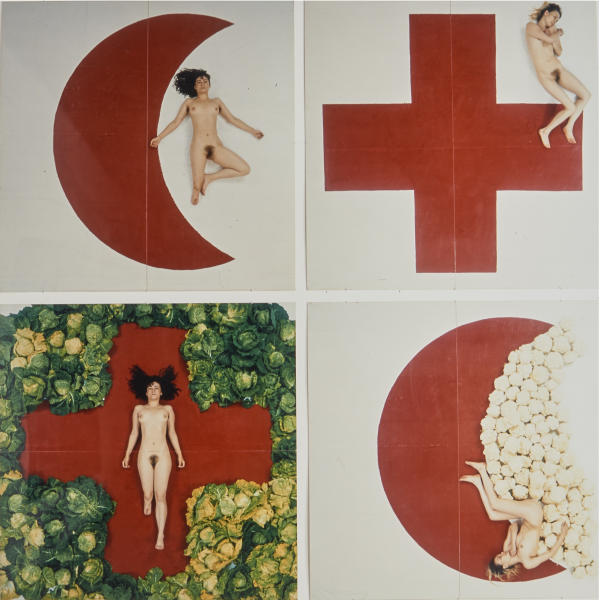Katarzyna Kozyra
Blood Ties
Blood Ties consists of four large-scale photographs depicting female bodies against the background of humanitarian organizations logos, the Red Cross and the Red Crescent, which are both based on religious symbols. The work was created as a response to news about the course of war in the former Yugoslavia. During the conflict, apart from mass murders of civilians, mass rapes of women – the helpless victims of the conflict – took place. Kozyra and her sister, shown in the photographs, became representatives of the sisterhood of victims, belonging on different sides of the cruel conflict. Their bodies exude vulnerability, especially in contrast to the menacing symbols, that have become radically ambiguous in this war. On the one hand, they represent religious and cultural differences – one of the main causes of the conflict in the former Yugoslavia, and on the other, point to the two sisterly humanitarian organizations that differ in religion but share a common goal: bringing aid to the victims of the conflict. The photographs of cabbage and cauliflower heads used in this work indicate a different kind of ambiguity. They depict symbols of nature and fertility, and also refer to farmland, which has turned into mass graves of the victims of war. In 1999, the AMS Outdoor Gallery scheduled to present two of the four photograms on billboards. This idea was met with protests from conservative and religious circles. As a result the images displayed in Warsaw were censored, and in most other cities they were not displayed at all.
Katarzyna Kozyra is one of the representatives of the 1990s critical art trend. Her work from that period, beginning with the 1993 Piramida zwierząt [Animal Pyramid], have gained great notoriety and became the subject of lively debate about contemporary art. Back then, Kozyra’s way of addressing topics such as death, old age, illness, and nudity was seen as scandalous. One of the most important themes in her work was corporeality, and showing sick and old bodies – commonly treated as something embarrassing and therefore generally excluded from being present in art. At least partially, the artist managed to contribute to changes in the current aesthetic canon of the female body functioning in the public sphere thanks to works such as Blood Ties (1995), Olimpia (1996) or Bathhouse (1997).
